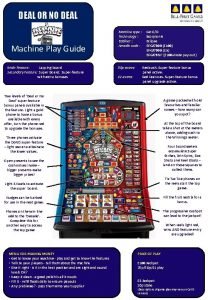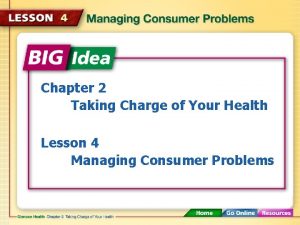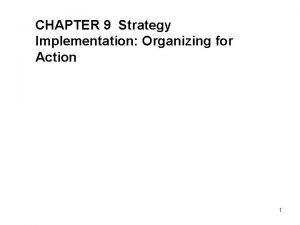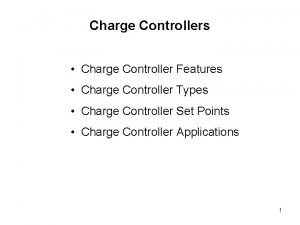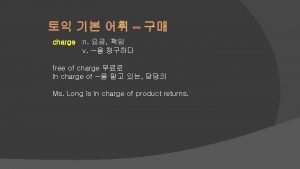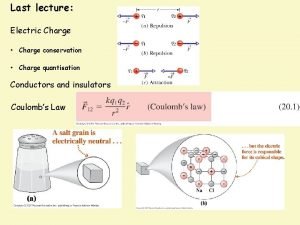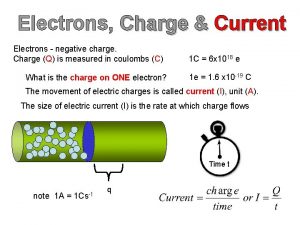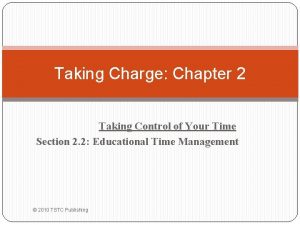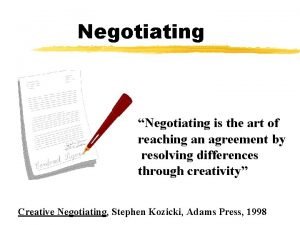TAKING CHARGE NEGOTIATING THE DEAL YOU WANT EVERY





























- Slides: 29

TAKING CHARGE! NEGOTIATING THE DEAL YOU WANT EVERY TIME ROSS R. RECK, Ph. D www. rossreck. com 602 -391 -3250

BASIC ELEMENTS OF SUCCESSFUL NEGOTIATING • Negotiation is all about people • People are motivated by self-interest • The entire negotiation process must be Win-Win • You must use a negotiation model that guarantees the deal you want every time


WIN-WIN PLANS

WIN-WIN PLANS • Determine your self-interest • Identify the people who stand between you and success or failure • Determine the other party’s self-interest • Develop a strategy to connect the other party’s self-interest with yours

Determine Your Self-Interest • Your self-interest needs to include three things: • Getting the other party to initially give you the deal you want • Getting the other party to continue giving you the deals you want • Getting the other party to become your goodwill ambassador

Identify the People Who Stand Between You and Success or Failure • • Decision makers Influencers Stakeholders Gatekeepers

Determine the Other Party’s Self-Interest • The key is listening • Listening involves the following: • • • Ask questions Listen to the other party’s responses Summarize (in your mind) what was said Feed this summary back to the other party Ask follow-up questions and repeat the process

Develop a Strategy to Connect the Other Party’s Self-Interest with Yours • Talk to the other party about what he or she wants first (that’s their Win) • Then show the other party what he or she needs to give you in return to get their Win (that’s your Win)

WIN-WIN RELATIONSHIPS

WIN-WIN RELATIONSHIPS • Plan situations that allow a relationship to develop • Cultivate the relationship • Don’t get down to business too quickly

Plan Situations that Allow a Relationship to Develop • • • Lunch Coffee Informal visits Coach a Little League or soccer team Get active in the PTA or your HOA Industry meetings or professional assoc.

Cultivate the Relationship • The key is to focus on them: • Become genuinely interested in the people you deal with • Be a good listener and encourage the people you deal with to talk about themselves • Try to see things from the other party’s point of view • Remember, you’re there for them

Don’t Get Down to Business too Quickly • If you do the other party will: • Question your motives • Decide he or she can’t trust you • Look to do business with someone else

WIN-WIN AGREEMENTS

WIN-WIN AGREEMENTS • Verify the other party’s self-interest • Implement your strategy to connect the other party’s self-interest with yours • Work together to resolve problems • Finalize the agreement

Verify the Other Party’s Self-Interest • The key is listening • Listening involves the following: • • • Ask questions Listen to the other party’s responses Summarize (in your mind) what was said Feed this summary back to the other party Ask follow-up questions and repeat the process

Implement Your Strategy to Connect the Other Party’s Self-Interest with Yours • Talk to the other party about what he or she wants first (that’s their Win) • Then show the other party what he or she needs to give you in return to get their Win (that’s your Win)

Work Together to Resolve any Problems • Dealing with problems • Once again, the key is listening • Hear the other party out completely • Work together as friends to come up with a solution that satisfies you both

Finalize the Agreement • Clear up any misunderstandings • Make sure both you and the other party are excited about the agreement • Put a system in place to resolve potential problems

WIN-WIN MAINTENANCE

WIN-WIN MAINTENANCE • Maintain the Agreement • Maintain the Relationship • Maintain the Plan

Maintain the Agreement • Work to prevent “buyer’s remorse” • Hold up your end of the Agreement • Provide meaningful expressions of appreciation to people who go the extra mile for you

Maintain Your Relationships • Spend time visiting with the people you deal with when you don’t ask for anything • If you find a problem—fix it—even if it’s not your problem

Maintain Your Plans • Develop a system of reminders that works for you • Examples: ________________________________

USING THE PRAM MODEL AS A DIAGNOSTIC AND PROBLEM SOLVING TOOL

COMMON NEGOTIATION PROBLEMS • • • New people People who are irate or upset People who are in power positions Objections Difficult people


KEYS TO MAKING THE PRAM MODEL WORK FOR YOU • Balance • Integrity • Patience
 Deal or no deal machine
Deal or no deal machine Asset deal vs share deal
Asset deal vs share deal Chapter 2 taking charge of your health lesson 3
Chapter 2 taking charge of your health lesson 3 Destiny 2 taking charge
Destiny 2 taking charge Chapter 2 lesson 4 managing consumer problems
Chapter 2 lesson 4 managing consumer problems The illusion of taking charge examples
The illusion of taking charge examples Taking charge of your health chapter 1
Taking charge of your health chapter 1 Spoken word poetry allows you to be anyone you want to be
Spoken word poetry allows you to be anyone you want to be Saunders lewis & thornhill 2009
Saunders lewis & thornhill 2009 Chapter 10 negotiating intersections
Chapter 10 negotiating intersections Negotiate sap license agreement
Negotiate sap license agreement The sign for an uncontrolled railroad crossing is a
The sign for an uncontrolled railroad crossing is a At an open or uncontrolled intersection, yield if _____.
At an open or uncontrolled intersection, yield if _____. Weiss’ strategic framework for negotiating
Weiss’ strategic framework for negotiating Pooled negotiating power
Pooled negotiating power An uncontrolled railroad crossing usually has
An uncontrolled railroad crossing usually has Chapter 7 negotiating intersections
Chapter 7 negotiating intersections Pooled negotiating power
Pooled negotiating power When you engage in unprocessed note taking, you
When you engage in unprocessed note taking, you Every nation and every country
Every nation and every country Microsoft's mission statement
Microsoft's mission statement Every knee shall bow every tongue confess
Every knee shall bow every tongue confess Every rotarian every year
Every rotarian every year Every nation and every country
Every nation and every country Every picture has a story and every story has a moment
Every picture has a story and every story has a moment Every child every day
Every child every day Difference between charge and electric charge
Difference between charge and electric charge Electrons flowing
Electrons flowing Personal characteristics of a valet
Personal characteristics of a valet Reported speech commands
Reported speech commands
